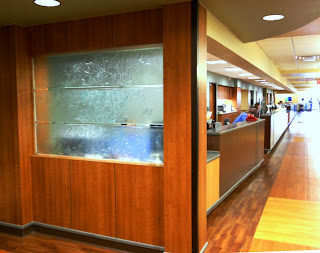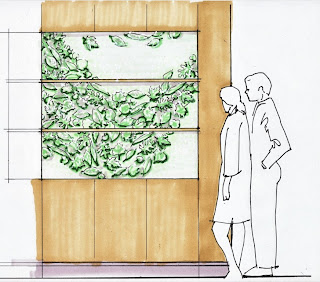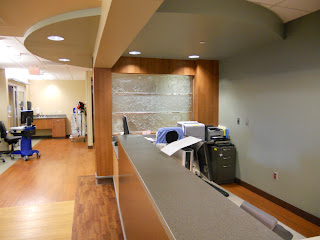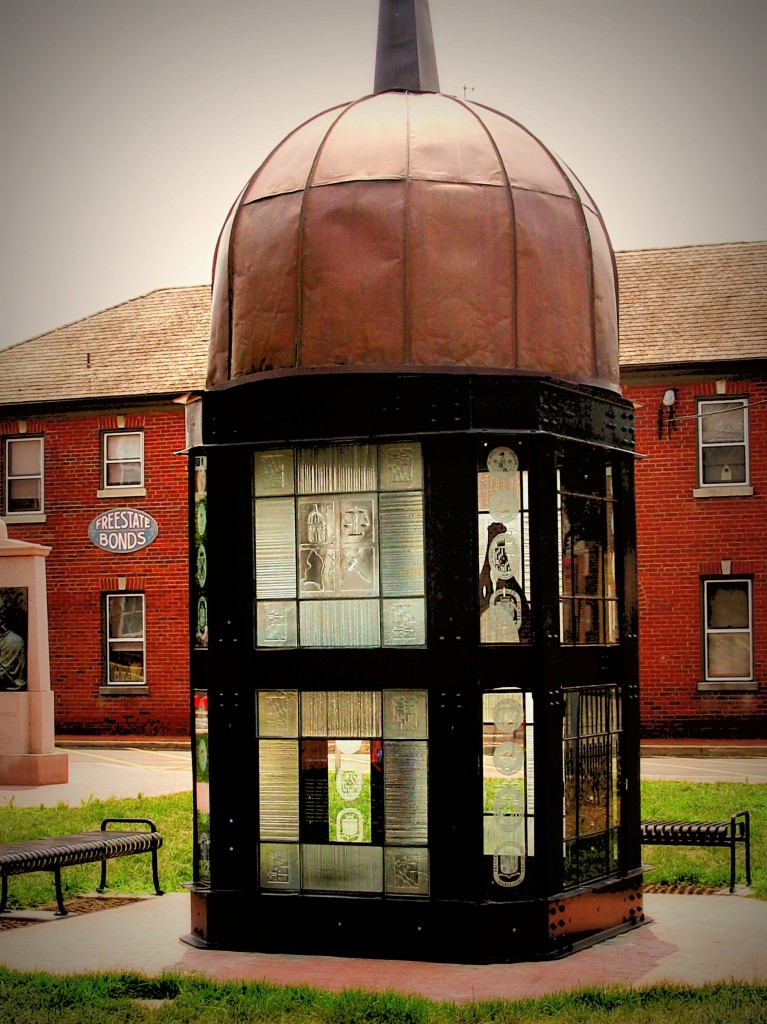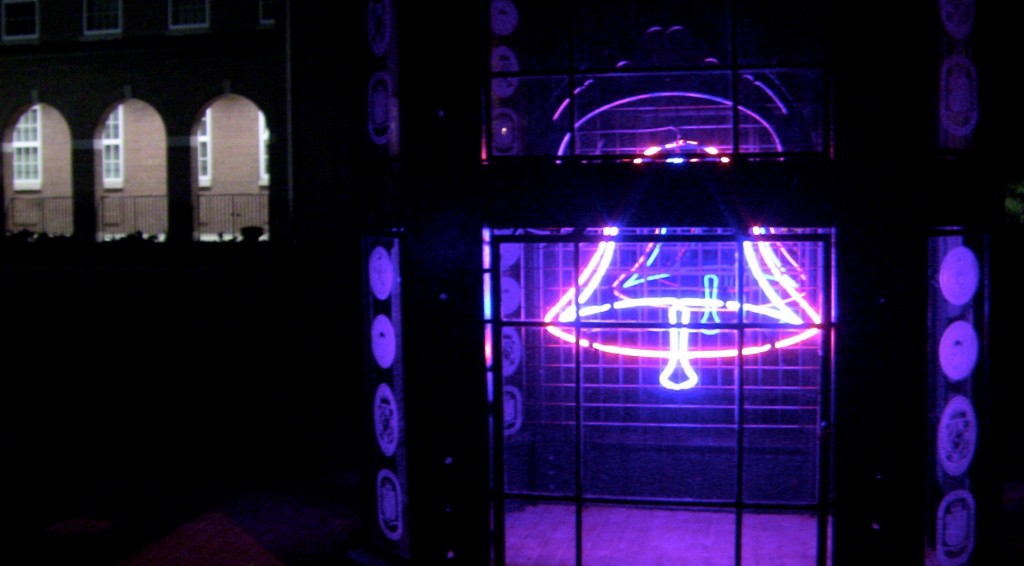>
Working with the architects on the project, the artwork commission was refined. The art panels would have to perform many duties – besides providing a screen to each floor’s nurse work area, allowing light to beyond, it would also need to block the viewing of sensitive papers and office equipment, as well as being a striking sculpture that would define the entry of each floor.
Design Concept
The initial concept design for the artwork at each floor’s nurse stations.
Preliminary artwork rendering layout. The inspiration was to bring a contemplative sense of nature into the hospital.
We wanted to bring the natural word into the medical center. Our goal was to give the patients and caregivers a place that felt restful – a place of healing and renewal. Our inspiration for the artwork was to have the feel of swirling masses of delicate oak, poplar, tulip, ginko and maple leaves in an autumn breeze. Each leaf is detailed, including curved stems and crisp leaf veins. The different level of the hospital would have unique swirling leaf patterns, allowing for differentiation and orientation.
One of the cast float glass panels inside the kiln.
Studio artist Nicole Puzan cleans and preps the cooled and annealed glass panel.

Typical nurse station cast artglass panel.
Typical nurse station reverse.
Detail of cast glass leaf pattern.
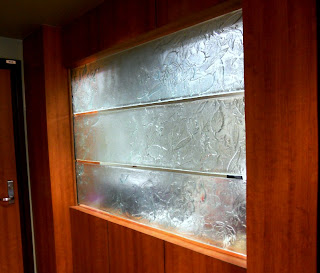
Front view of artwork.
View of panels showing leaf detailing.
The Washington Glass Studio artglass project team: Tim Tate, Michael Janis, Erwin Timmers and Nicole Puzan and Robert Kincheloe.
CASE STUDY: Glass Sculpture as Public Art
Prince George’s County Circuit Courthouse
If you have been following the ongoing story of the Washington Glass Studio’s design and progress of the installation of Prince George County’s Upper Marlboro courthouse glass public art sculpture – the installation is almost complete. As described in the June 2009 blog posting –
The historic 1939 Circuit Court building was devastated by fire in 2004, completely destroying the ornate Duvall Wing. The old bell tower that was atop the portico entry had been reduced to the structural frame and the historic bell within had crashed down to the ground during the fire.
The cupola’s 124-year-old bell fell through the second floor during the fire and was buried in the rubble. (photo: Mark E. Brady — Prince George’s County Fire/emergency Medical)
For a number of years, during the renovation of the courthouse, the bell tower structure continued to deteriorate on what had become a construction site for both the courthouse expansion and the renovation of the damaged courthouse.

The structural remains of the original 1939 bell tower cupola.
In 2008, Prince George’s County asked two of the artists that had made artwork for the interior of the Marbury Wing court expansion to collaborate and come up with some concepts for the front entry courtyard of the refurbished court building as it neared completion. Early on, the decision was made to restore the original bell tower cupola as the center point of the public artwork sculpture, and that informed the many design concepts explored. Infill panels made of cast glass with courthouse/legal imagery, sandcarved glass infill panels, backlighting with computer controlled LED panel lighting effects, neon lighting – were some of the many different ideas that were explored and the design options were narrowed down, documented and presented to the courthouse committee, headed by Circuit Court Judge Sheila Tillerson-Adams.
Different concepts of integration of lighting and cast recycled glass were explored.
Titled “Rebirth and Renewal “, the concept was modified with input from the judges and the committee, and in late 2009, the original steel structure and copper dome top was restored and set into a new paved area outside the courthouse, near the main courthouse entry. Glass began being cast into bas-relief panels with imagery based on the courts, the legal system, Prince George’s County, and the original court building.
Cast bas-relief panels made from recycled glass were made with court and community based imagery. Michael Janis begins coldworking the panels. Nicole Puzan installs the cast textured panels into the steel framework.
Steel frames were made for the glass panel infill support. Neon artist Marty King made a neon representation of the original bell of the bell tower, which, by tradition, was struck at 9.30 am each day court was in session. An engineer certified the original bell tower cupola’s structural integrity for the modifications and reuse. Custom benches for seating around the artwork were started. The chamfered corner panel infills were designed to incorporate detailed county seals representing the counties served by the Circuit Court. These panels were clear, with deep, intricate sandcarved panels. In December of 2009, all the elements were coming together, and installation of the cast glass began.
Erwin Timmers tests the neon. Erwin Timmers and Alonzo Davis bolt the infill panels to the steel structure.
During the installation, the Washington, DC area was hit by two snowstorms that dumped the largest amount of snow ever recorded in the area’s history, and installation had to work around the snow removal efforts.
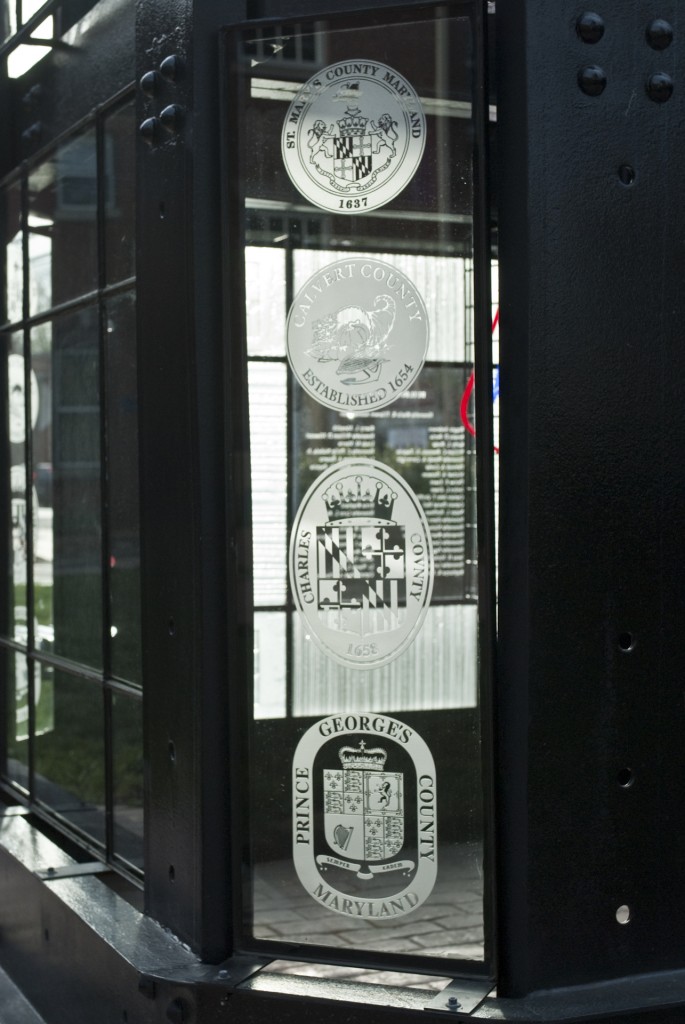
The Circuit Court for Prince George’s County shares the Seventh Judicial Circuit with the Circuit Courts for Calvert, Charles and St. Mary’s counties. Seals of each of the counties are presented in the artwork.
The names of the Circuit Court refurbishment committee are acknowledged in sandcarved panels mounted in the glass and steel sculpture. The cast recycled glass alternates with clear glass to allow alternating views looking into the neon bell sculpture and allowing diffused lighting from the neon to illuminate the cast glass symbols.The final elements were recently installed, and the neon switched on.
